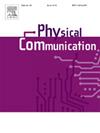Resource allocation scheme for multi-cluster NOMA-SWIPT systems with multiple IRSs
IF 2
4区 计算机科学
Q3 ENGINEERING, ELECTRICAL & ELECTRONIC
引用次数: 0
Abstract
To address the challenge of providing seamless cellular connectivity for a massive number of Internet-of-Things (IoT) devices within limited resources, this paper integrates non-orthogonal multiple access (NOMA), simultaneous wireless information and power transfer (SWIPT), and intelligent reflecting surface (IRS) technologies. Considering practical factors such as imperfect channel state information (CSI), non-ideal successive interference cancellation (SIC), and non-linear energy harvesting (EH), this paper constructs a multi-cluster NOMA-SWIPT transmission model assisted by multiple IRSs. For this model, with the aim of maximizing system energy efficiency (EE) under constraints such as maximum base station (BS) transmit power, IRS reflection phase shifts, minimum transmission rate, and minimum energy harvesting (EH), a non-convex resource allocation problem is formulated. The solution to this problem requires the joint optimization of the BS transmit beamforming vectors, IRS reflection phase shifts, and power splitting (PS) ratios. To address this challenge, the original problem is initially decomposed into three non-convex sub-problems. Subsequently, by employing Schur’s complement, the S-procedure, General sign-definiteness, and successive convex approximation (SCA), these non-convex sub-problems are transformed into solvable convex optimization sub-problems. Finally, an alternating iterative method is proposed to solve these sub-problems, thereby addressing the original resource allocation problem. Simulation results validate not only the convergence of the robust resource allocation scheme based on alternating iteration but also demonstrate that leveraging the close-range coverage of IRSs can significantly enhance system energy efficiency, even under non-ideal SIC and imperfect CSI conditions.
具有多个irs的多集群NOMA-SWIPT系统的资源分配方案
为了解决在有限资源内为大量物联网(IoT)设备提供无缝蜂窝连接的挑战,本文集成了非正交多址(NOMA)、同步无线信息和电力传输(SWIPT)和智能反射面(IRS)技术。考虑不完全信道状态信息(CSI)、非理想连续干扰抵消(SIC)和非线性能量收集(EH)等实际因素,构建了一个多簇多irs辅助下的NOMA-SWIPT传输模型。针对该模型,在最大基站发射功率、IRS反射相移、最小传输速率和最小能量收集(EH)约束下,以系统能量效率(EE)最大化为目标,构造了一个非凸资源分配问题。解决这一问题需要对BS发射波束形成矢量、IRS反射相移和功率分割(PS)比进行联合优化。为了解决这一挑战,最初将原始问题分解为三个非凸子问题。随后,利用Schur补、s过程、一般符号确定性和连续凸逼近(SCA),将这些非凸子问题转化为可解的凸优化子问题。最后,提出了一种交替迭代的方法来求解这些子问题,从而解决了原始的资源分配问题。仿真结果不仅验证了基于交替迭代的鲁棒资源分配方案的收敛性,而且表明即使在非理想SIC和不完美CSI条件下,利用irs的近距离覆盖也可以显著提高系统的能源效率。
本文章由计算机程序翻译,如有差异,请以英文原文为准。
求助全文
约1分钟内获得全文
求助全文
来源期刊

Physical Communication
ENGINEERING, ELECTRICAL & ELECTRONICTELECO-TELECOMMUNICATIONS
CiteScore
5.00
自引率
9.10%
发文量
212
审稿时长
55 days
期刊介绍:
PHYCOM: Physical Communication is an international and archival journal providing complete coverage of all topics of interest to those involved in all aspects of physical layer communications. Theoretical research contributions presenting new techniques, concepts or analyses, applied contributions reporting on experiences and experiments, and tutorials are published.
Topics of interest include but are not limited to:
Physical layer issues of Wireless Local Area Networks, WiMAX, Wireless Mesh Networks, Sensor and Ad Hoc Networks, PCS Systems; Radio access protocols and algorithms for the physical layer; Spread Spectrum Communications; Channel Modeling; Detection and Estimation; Modulation and Coding; Multiplexing and Carrier Techniques; Broadband Wireless Communications; Wireless Personal Communications; Multi-user Detection; Signal Separation and Interference rejection: Multimedia Communications over Wireless; DSP Applications to Wireless Systems; Experimental and Prototype Results; Multiple Access Techniques; Space-time Processing; Synchronization Techniques; Error Control Techniques; Cryptography; Software Radios; Tracking; Resource Allocation and Inference Management; Multi-rate and Multi-carrier Communications; Cross layer Design and Optimization; Propagation and Channel Characterization; OFDM Systems; MIMO Systems; Ultra-Wideband Communications; Cognitive Radio System Architectures; Platforms and Hardware Implementations for the Support of Cognitive, Radio Systems; Cognitive Radio Resource Management and Dynamic Spectrum Sharing.
 求助内容:
求助内容: 应助结果提醒方式:
应助结果提醒方式:


